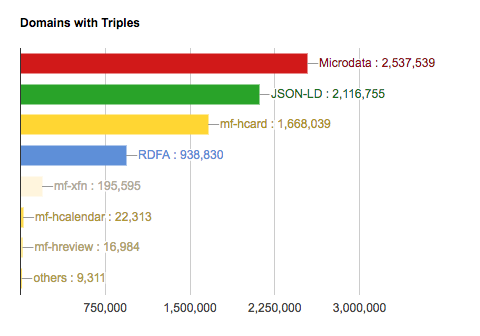Are there some recent and reliable statistics about "Web use" (webpages using one standard or another) of these standards?
Or an specific statistic about vCard (person and/or organization) scope of use?
Only statistics, this question is not about "what the best ideia?" or "how to use it?". Looking for statistics numbers to compare Microformats adoption with (any kind of) RDFa in HTML adoption.
We can considere, for "counting pages" statistics, that Microdata is a kind of RDFa-HTML.
NOTES
Explain context
The RDFa Lite is the only W3C recommendation, when we talk about "Microdata vs Microformat", and Microdata have a better map to RDFa Lite. HTML5 has become a W3C Recommendation in 2014-10-28, and neither one was blessed by W3C. I understand that schema.org is the best way to adopt (reuse community-schemas) RDFa.
By other hand Microformats is older, and the most simple; so, perhaps, the most used in the Web (!? is it?).
About "vCard data statistics"
If we need some scope for the statistics, let's use vCard as scope:
Microformat's hCard and h-Card are standards for display vCards on (any) HTML, and was used for people and organizations.
schema.org's Person and Organization encodes vCard information with (standard) RDFa Lite or Microdata.
Other notes
Wikipedia express an old (2012's) and not-confirmable assertion (no source!), "Microformats such as hCard, however, continue to be published more than schema and others on the web", and Webdatacommons is a mess, no statistical report.
(edit) now Wikipedia's citation error is fixed.
(edit after @sashoalm comment) Note for those who disagree that this question is valid.
This question is a software problem, not a "request for off-site resource"...
PROBLEM: to decide what library, framework, data-model, etc. in a project, we need to use tools that are in use today and in the next few years... To make project decisions in a software development, we need statistics about user tendency, framework adoption, etc.
PS: here in Stackoverflow there are a lot of discussions about language statistics, that is the same "set of problems". Example: 1, 2, 3,4, 5, 6. See also the questions tagged with [usage-statistics].





